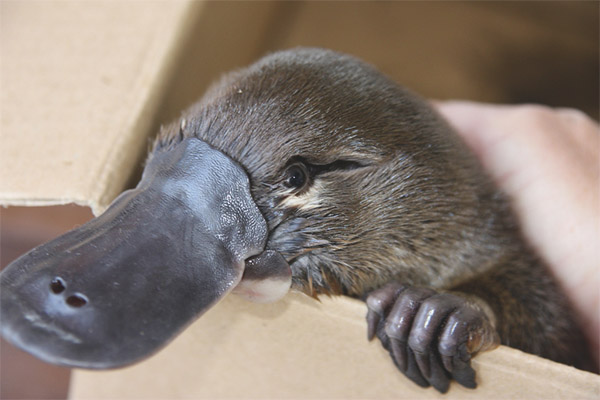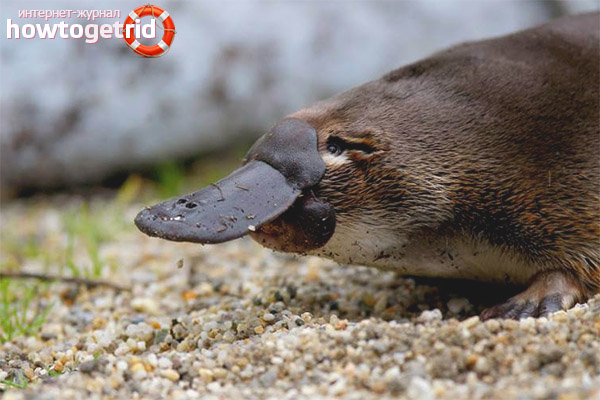The content of the article
The platypus is a very special way of evolutionary development, and it is possible to talk about it quite a lot, which, in fact, we will deal with further. Indeed, in this beast there is a mass of paradoxes and amazing features.
At first, when the European animals brought the remains, which the platypus had previously been, they did not believe at all in the existence of such an animal and considered it brought by a joke. The duck's beak and some strange tail were attached to the beaver's fur - this is exactly what the platypus looks like. However, in the future, the fact of the existence of this animal was confirmed and began to be studied in more detail.
Who is the platypus
As you know, scientists for convenience classify all animals. Strict division allows you to understand what features have different animals, who came from whom and much more.
As mentioned earlier, the platypus is a separate branch of evolution, so at first they could not understand at all which class it was assigned to.
- It has a beak and could well be called a bird, but it has fur like animals.
- It has one outlet (cloaca) like reptiles or birds, but the female feeds the children with milk, like beasts.
- The females, although they are mammals (while the mammary glands as such are absent, and the female simply releases the milk on the surface of the abdomen, from where the platypus licks it), but lay eggs, again like birds and reptiles.
Thus, there are signs that point to different classes of living beings and generally confuse and initiate a logical question - how can such a thing exist. By the way, many for this reason consider this animal to be a manifestation of a peculiar sense of humor in nature and evolution.
However, we will not be distracted by the humor of nature, but let us return to the classification of scientists who created for platypuses and echidnas (also rather strange animals who also come from Australia, where there are generally quite a few strange representatives of the animal world) a separate unit in the classification.Now, the platypus and echidna are representatives of the egg-laying order (also monotremes, cloacal or primary subclass), which have a set of features characteristic only of them.
The most interesting thing in egg-laying is the presence of many reptilian traits. However, they are not the ancestors of marsupials or any other animals. They developed completely separately and thus became something amazing, not like any other living creatures.
Features that the platypus has
Many have not seen this beast, even in zoos, only in pictures or videos. Therefore, people often do not even represent some basic facts about the platypus:
- Its beak is actually soft and represents the skin, which is stretched between two arcuate bones, running along the sides.
- The beak is used for a special feeling - electroreception, which is the recognition of electromagnetic field pulses from other animals, in particular, the platypus thus searches for different intervertebrates in water and feeds on these creatures - also with the help of a beak.
- Paws, he puts on the sides of the body like reptiles, and not animals, which hold their four legs under the body during walking. By the way, thanks to this, the testicles of male platypuses do not require a scrotum, since the surface of the body remains cool and spermatogenesis (which requires a little cooler temperature than the general body temperature) can proceed normally.
- The males of the platypus have a forked penis - also like reptiles, and the females have only one ovary, from which a pair of eggs hatch, which ten days after being in the duckweed hole give small platypuses.
- Individuals open the shell of their own eggs with a special tooth on the beak, which is called the egg and falls off after a certain amount of time, like the milk teeth of people, for example.
- Platypus is a poisonous animal, and for a mammal this state of affairs is extremely rare. A spur on its hind legs may well send an animal the size of a dog to the next world, and if a platypus hits such a spur a person, then he (that is, a person, not a platypus) will experience significant torment for two or three days in a row, and these pains will not even strong anesthetics are removed.Therefore, do not anger the platypuses (especially males, in females these spurs disappear with age).
- The platypus is able to growl like a terrible predator and also makes other sounds that are also quite original.
- The platypus becomes bald with age, mainly in the area of the tail. Also, young males have teeth that wear away with age.
Generally speaking, the platypus is a combination of the incongruous, it has a tail and an otter's paws and a duck-like beak. He lays eggs, and the young feeds with milk, it’s fit to say about this - a miracle of nature.
More seriously, such creations of nature allow us to see how many different ways evolution can go and how many options for living beings nature can create. Such creatures allow you to dream and learn a lot. On this basis, it is easy to understand - the possibilities of nature are endless.
Body structure
The platypus is a fairly compact creature that weighs up to 3 kilograms with a body length of up to 60 centimeters, a quarter of this length is occupied by the tail. Females in size, usually smaller than males, do not have a spike on their hind legs after the first year of development.
They have rather small eyes, but they see a lot and also hear perfectly, but these feelings do not work under water. Therefore, diving, they use electroreception (this feeling allows you to catch, for example, the impulses that emanate from the contraction of the muscles of other animals), and drive their heads to the sides in order to look for their prey like shit or sharks. Its fur is soft, thick, color is dark. The eyes and ears are located in the depressions that close when submerged under water, the nostrils are also closed with special valves so that the water does not penetrate into these cavities.
Duckbill paws, which have a hybrid structure and can be effectively used both in water and on land, deserve special attention. In order to swim normally, there are membranes between the toes of the paws, which fold up in a special way on land and allow the claws to protrude. The platypus not only moves rapidly along the ground, but also digs the ground very well and builds various minks for its own residence.
In conclusion, this paragraph should note the physiological feature, which is the ability to regulate the temperature of his own body. In fact, the platypus combines the ability of reptiles and animals.On land, it maintains a temperature of just over 30 degrees, but if it dives in cold water a lot, then it reduces its own temperature to 5 degrees Celsius and thus perfectly adapts to external conditions.
Habitat and behavior
The platypus lives mainly in Australia and Tasmania, it is a rather shy creature, so seeing the platypus is walking or swimming is rather difficult.
This amazing beast spends a lot of time in the water, where it feeds on various worms and crustaceans. He eats in large quantities, because he does not have a stomach. In this way, the platypus can eat food approximately equal to its own weight, because the incoming “products” are not digested in the stomach (which is absent) but are immediately in the intestine.
The platypus enters a kind of symbiosis with the Australian cormorant. In the period of his swimming and diving to the bottom, he raises the silt and flushes out the fish, which float to the surface and thus provide themselves to cormorants. Therefore, if the platypus just swims and does not dive, cormorants sometimes slightly “cheer” him up with their beak, so to speak, hinting that it dives again and drives the fish to the surface.
These animals prefer clean water bodies, but in general are not particularly demanding, and therefore they inhabit almost any more or less corresponding to the required conditions water bodies of eastern Australia. Although the animals are rather shy, you should not use the availability of platypus and flirt with them.
The most active wonderful animals at night. Dive for prey 75 times every hour and stay under water for about 40 seconds. Thus, they are quite active and have little rest, continuing to "work" incessantly in search of food.
In the morning, the platypus returns to its own burrow, where it rests throughout the day. In order to be dry in his dwelling, he makes a narrow entrance to the burrow and, when he creeps in there, he wipes his own fur on the edges, freeing himself from excessive moisture, which is fixed on his fur.
Video: Platypus (Ornithorhynchus anatinus)














To send